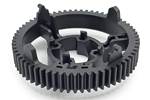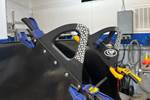CRP Technology launches Windform SL for UAV needs
Carbon fiber-reinforced polyamide, added to CRP’s Top-Line series, is well suited to demands for lightness, stiffness and thermal resistance in composites 3D printing.
Windform SL targets the UAV/UAS sector. Source | CRP Technology
3D printing service bureau CRP Technology (Modena, Italy) introduces Windform SL, the 12th material in the Windform Top-Line additive manufacturing (AM) series. A black carbon fiber-reinforced polyamide composite, Windform SL combines ultra-light (designated by the “SL”), rigid characteristics with a low density of 0.87 g/cc, ensuring light weight without the need to reduce thickness.
Designed specifically for powder bed fusion/selective laser sintering (PBF/SLS), Windform SL is particularly well suited for producing functional prototypes and components in the UAV/UAS sector, and applications demanding a balance of lightness, stiffness and thermal resistance, such as automotive.
A heat deflection temperature (HDT) of 182.5°C at 1.82 MPa, combined with high values in specific tensile modulus, specific tensile strength and impact strength (Charpy and Izod), are among Windform SL’s key features, which provide it with the ability to maintain structural stability under intense stress, even at elevated temperatures, ensuring reliable performance in demanding environments.
CRP Technology says that its post-process surface finish is equally noteworthy, with Ra values of 5.44 µm after the SLS process, 1.56 µm after manual finishing, and 0.83 µm after CNC processing, ensuring smooth and precise surfaces.
Related Content
-
Otto Aviation launches Phantom 3500 business jet with all-composite airframe from Leonardo
Promising 60% less fuel burn and 90% less emissions using SAF, the super-laminar flow design with windowless fuselage will be built using RTM in Florida facility with certification slated for 2030.
-
Co-molding SMC with braided glass fiber demonstrates truck bed potential
Prepreg co-molding compound by IDI Composites International and A&P Technology enables new geometries and levels of strength and resiliency for automotive, mobility.
-
Low-cost, efficient CFRP anisogrid lattice structures
CIRA uses patented parallel winding, dry fiber, silicone tooling and resin infusion to cut labor for lightweight, heavily loaded space applications.



